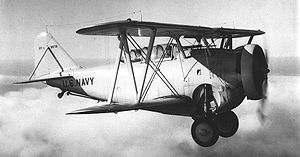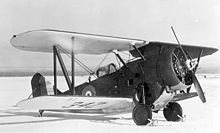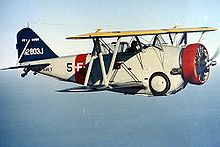Grumman FF Video - Picture

|
|
Grumman FF
FF / SF "Fifi"

Role: Naval fighter
Manufacturer: Grumman
Designed by: Leroy Grumman
First flight: 29 December 1931
Introduced: June 1933
Retired: 1940
Primary users: United States Navy
Spanish Republican Air Force
Royal Canadian Air Force
Produced: 1932-1934
Number built: 120
Variants: Grumman F2F
The Grumman G-5 design was an American biplane fighter aircraft operated by the United States Navy during the 1930s, designated FF-1. It was the first Navy aircraft with retractable landing gear.
Design and development
The FF-1 was Grumman’s first aircraft design for the US Navy. The prototype XFF-1 (serial number A8878) was built to a contract placed on 22 April 1931, first flying on 29 December of that year. A two-seat design, with an enclosed cockpit, fuselage of all-metal construction, and wings covered largely with fabric. The XFF-1 was powered initially by a 616 hp (459 kW) Wright R-1820-E Cyclone radial engine, it achieved 195 mph (314 km/h) during service trials, and when the original engine was exchanged for a 750 hp (560 kW) Wright R-1820-F Cyclone the XFF-1 reached a top speed of 201 mph (323 km/h), faster than any US Navy fighter in service at the time.
A production order was placed for 27 two-seat FF-1 (G-5) on 19 December 1932. Meanwhile Grumman had completed a second prototype (serial number A8940) to a two-seat scout configuration as the XSF-1 (G-6). Subsequently 33 production SF-1s were ordered based on the two-seat configuration. They differed from the FF-1 principally in having revised internal equipment and in being powered by R-1820-84 Cyclones instead of the R-1820-78 model installed in the fighter version. One XSF-2 was also completed, this having a Pratt & Whitney R-1830 Wasp engine in place of the Cyclone.
Operational history
FF-1s were delivered to Fighter Squadron VF-5B of the USS Lexington beginning in June 1933. In service the FF-1 became familiarly known as the "Fifi". Delivery of SF-1s started in 30 March 1934, and they also served aboard the Lexington, with Scout Squadron VS-3B.
Both the FF-1 and SF-1 were withdrawn from first-line US Navy squadrons by the end of 1936 and reallocated to reserve units, most of the FF-1s still being in service late in 1940. Later, 22 surviving FF-1s were modified with dual controls, redesignated FF-2 and used for instructional duties.

Picture - CC&F Goblin I c. 1941
The Canadian Car & Foundry Co acquired a manufacturing licence for the FF-1, of which it completed a total of 57, some of them assembled from US-built components. A total of 40 aircraft were acquired by the Spanish Republican Government in 1937 via intermediaries from Turkey. This batch was built primarily to bypass the US embargo placed on belligerents during the Spanish Civil War. Referred to as the GE-23 Pedro Rico by the Spanish Republican Air Force, the aircraft were used in the conflict, but were not well matched against their chief opponent, the Fiat CR.32, although one victory against a Heinkel was the only recorded "kill" by a Grumman biplane fighter. Eight survived to serve in the Ejército del Aire Espax±ol as the Delfin (Dolphin).
Although initially rejected as a fighter by the Royal Canadian Air Force as outdated and too slow, with the advent of war, the last 15 of the CC&F production batch were accepted as the Goblin I. The aircraft type served with the RCAF from 17 September 1940 until 21 April 1942. "A" Flight of No. 118 RCAF Sqn was equipped with Goblins at Rockcliffe in Ottawa, and subsequently became No. 118 (Fighter) Sqn., later stationed at Dartmouth, Nova Scotia where the Goblins for a time constituted the sole fighter force on the east coast.
Prior to this RCAF use, a single example was delivered to Nicaragua, and allegedly, one to Japan. The sole G-23 purchased by the Nicaraguan government saw limited service before being relegated to a scrap yard at Zololtan Air Field in 1942, destined to remain there until 1961. A US aerial applicator, J.R. Sirmons, discovered the G-23 and purchased the fighter. In 1966, Grumman Aircraft acquired and restored the aircraft before passing it to the US Navy where it remains as one of the displays at the Naval Aviation Museum at Pensacola, Florida.
Operators

Picture - The U.S. Navy Grumman FF-1 N2803J in flight.
Canada
Royal Canadian Air Force
Japan
Imperial Japanese Navy
one Canadian-built example under the designation AXG Nicaragua
Military Aviation Corps
Spanish Republic
Spanish Republican Air Force via Turkey
United States
United States Navy
Variants
XFF-1
single prototype, serial number A8878
FF-1
27 built, two-seat U.S. Navy carrier-borne fighter
FF-2
25 of the original FF-1 fighters converted by the Naval Aircraft Factory with dual controls to serve as fighter trainers
XSF-1
second prototype, serial number A8940
SF-1
33 built, two-seat U.S. Navy carrier-borne scout
XSF-2
one aircraft, an SF-1 airframe with the 650 hp (485 kW) Pratt & Whitney R-1535-72 Twin Wasp Junior engine driving a Hamilton Standard propeller
G23 Goblin
57 FF-1s built under licence by the Canadian Car & Foundry Company
XSBF-1
the XSF-2 airframe modified with a triangular frame beneath the engine mounting to carry one 500 lb (227 kg) or two 100 lb (45 kg) bombs, flown 18 February
1936
AXG1
A single Grumman FF-2 supplied to the Imperial Japanese Navy Air Service for evaluation in 1935.
Specifications (FF-1)
Data from "The Complete Encyclopedia of World Aircraft"
General characteristics
Crew: 1
Length: 24 ft 6 in (7.47 m)
Wingspan: 34 ft 6 in (10.52 m)
Height: 11 ft 1 in (3.38 m)
Wing area: 310 ft² (28.8 m²)
Empty weight: 3,098 lb (1,405 kg)
Max takeoff weight: 4,677 lb (2,121 kg)
Powerplant: 1x— Wright R-1820-78 Cyclone radial engine, 700 hp (520 kW)
Performance
Maximum speed: 207 mph at 4,000 ft (333 km/h)
Range: 685 mi (1,100 km)
Service ceiling: 22,100 ft (6,735 m)
Rate of climb: 1,667 ft/min (508 m/min)
Armament
2x— 0.30 in (7.62 mm) M1919 Browning machine guns
1x— 100 lb (45 kg) bomb
Related development
Grumman F2F
Bibliography
Cacutt, Len, ed. "Grumman Single-Seat Biplane Fighters." Great Aircraft of the World. London: Marshall Cavendish, 1989. ISBN 1-85435-250-4.
Fitzsimons, Bernard, ed. The Illustrated Encyclopedia of the 20th Century Weapons and Warfare. New York: Purnell & Sons Ltd., 1967/1969, ISBN 0-83936-175-0.
Green, William, ed. "The Strange Story of Grumman's First Fighter".Flying Review International, Volume 22, No. 2, October 1966.
Green, William and Gordon Swanborough. The Complete Book of Fighters. New York: Barnes & Noble Inc., 1988, ISBN 0-07607-0904-1.
Levy, Howard. "All the Way Home." Air Progress, Volume 19, No. 4, October 1966.
Levy, Howard. "Canadian-built Goblin Restored." Canadian Aviation, Volume 39, No. 12, December 1966.
Listemann, Phil H. Alied Wings No.6: Grumman FF'. France: www.RAF-in-combat.com, 2008. ISBN 2-9532544-0-2.
Swanborough, Gordon and Peter M. Bowers. United States Navy Aircraft Since 1911. Annapolis, Maryland: Naval Institute Press, 1976. ISBN 0-87021-968-5.
Winchester, Jim. Fighters of the 20th Century. Shrewsbury, UK: Airlife Publishing Ltd., 2002. ISBN 1-84037-388-1.
Grumman FF Pictures and Grumman FF for Sale.
Living Warbirds: The best warbirds DVD series.
Source: WikiPedia